
Here we go! Hi everyone and welcome to our kick-off issue of ArtsyFartsy News. It's filled with a smattering of all types of news, stuff that's on my mind and updatess about my new products. We're not going to be boring or too snooty. That's why we're calling this ArtsyFartsy. We refuse to be so serious! We plan on providing it free to you on a monthly basis. You can forward ArtsyFartsy News to your friends and other artists who you think will enjoy it, but they have to sign up to receive their subscription.
New Product Update

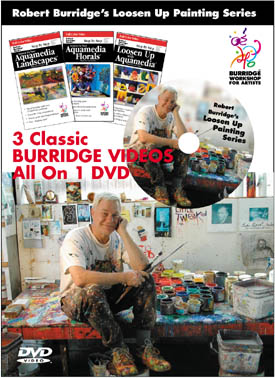

We have a new DVD. We combined all 3 of our popular Loosen Up Painting series that before were only available on VHS Video, on to 1 DVD. This DVD includes all 3 videos together, is 145 minutes long and cover lots of loosen up techniques, floral subjects as well as plenty of landscape painting. I take you through my 20 Top Secrets to Loosening Up plus warm-up exercises, composition and values, all in my country barn studio. Increase your passion to paint more and have fun while you're doing it!
For info on ordering go to:
www.robertburridge.com

Burridge Workshops
My 2007 workshop schedule is complete! Best way to find out where my Loosen Up, Abstract or Collage workshops are being held, check out Workshop Schedule on my website. We are traveling all over the country this year to many new locations:
• San Juan College in Farmington, NM
April 11-13
They are also featuring my new Abstract Figurative work in their Art Gallery.
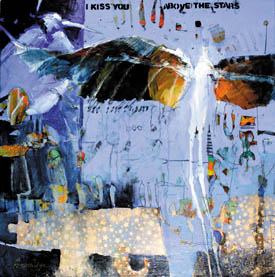
I Kiss You Above the Stars

• Cheap Joe's Art Stuff, in Boone, NC
Trade Show, June 14-16
• Cloudcroft Art Workshops in NM
July 9-13
• Dillman's Bay Resort
Lac du Flambeau, WI
September 9-14
• Northwest Watercolor Society
Seattle, WA
October 22-26
I'll be teaching a 5-day Workshop and jurying their exhibit.
And... if you are looking for an adventure of a lifetime...
• Explore Guatemala Art Workshop /Tour
November 12-21
This past June we painted in France for 2 weeks. Each week was designed as a Master Class/Mentor program with a maximum of 6 students. We lived in a castle, about 2 hours south of Paris. A fabulous painting experience in villages, cities and cafes. We added a new feature on our website: Workshop Photos. Go there and see some of our favorite travelog photos of France.

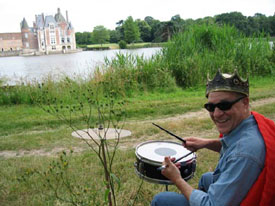
Bob drumming in France

Burridge Exhibitions
This year's solo exhibitions are scheduled for New Mexico, at San Juan College in Farmington (where I'm also teaching a workshop). I am the featured artist for March at Kinion Fine Art Gallery in Sedona Arizona.

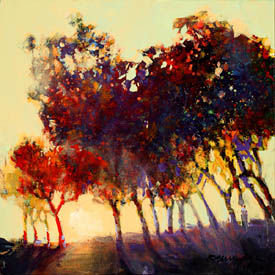
Sunrise Sunset
"Canyons and Headlands at Kinion"
Reception
First Friday, March 3, 2007 5-8 pm
Kinion Fine Art
431 Hwy 179, Sedona, AZ
928/203-0234
www.kinionfineart.com
Holbein Mat Acrylic
Introduction


Demo of Holbein Mat Acrylic
A hot new paint product from Holbein!
Tim Hopper, Marketing Guy for Holbein recently introduced to me a brand new paint. It's a Mat Acrylic line of paints. Very popular and a big seller in Europe. It's available in many colors, of course, but what makes this product so unusual is its artist friendly package design. It's a collapsible bag. Think IV bag. It is also available in a plastic squeeze tube. Like toothpaste, the paint stays fresh. You squeeze both the paint and the air out simultaneously. The paint has a uniform consistency, smooth and very creamy quality. It's a beautiful paint. I paint with it on paper as well as on canvas. The painting dries mat with a velvety finish. And, just for fun, I've also brushed a semi-gloss varnish on a few. You can order this paint from Black Horse Fine Art Supply, www.black-horse.com. Their discount catalog is online. Black Horse has the reputation of being one of the nicest companies around.
No Risk - No Art!
I was recently honored to jury the 2007 San Diego Watercolor Society's "Experimental Juried Show" at their brand new, exquisite location in Point Loma, California. The "call for entries" generated the most entries ever for an Experimental Show - 290 entries. My assignment was to choose the top 90 (no pressure there!). From my years of experience in jurying exhibits, I've established a few guidelines that help me to take on this monumental task. Pure talent and technical expertise aside, I choose work with the following criteria:
Just by looking I could tell if...
• Commitment: The artist was committed to the work.
• Personal: The subject reflected the artists' personal interests.
• Big Risk-taking: The artist was impulsive and intuitive. No risk in art sends a message of self-doubt and usually is failure-prone.
And, believe me, you and I can look at any painting and decide if the artist was committed to it, the subject was personal and the artist took risks.
Professional execution never got my attention - sometimes these are too slick and too technically accurate. Boring to me! I'm reminded that the ark was built by an amateur... the Titanic was built by professionals. For me, substance trumps technique.
Keeping this in mind, listen to this: Forum Gallery is a successfully celebrated bicoastal gallery with unique, contemporary and cutting edge paintings. Their director, Robert Fishko explains succinctly what makes Forum's reputation so outstanding. The following is an excerpt from a recent interview from Art & Living magazine: "We are always interested in artists whose work pushes at the boundaries. We show art that sends a strong and original message, that shows an aspect of life in a way we haven't seen before... Our art collectors are interested in art that communicates feeling and respect for the panoply of human life... and art that enriches peoples' lives."
I'd like to add another poignant quote from pop artist Gerhard Richter: "Painting is the making of an analogy for something non-visual and incomprehensible, giving it form and bringing it within reach, and that is why good paintings are incomprehensible."

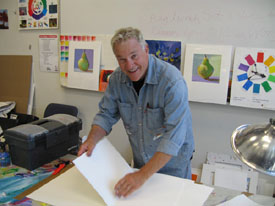
Bob preparing paper
Art Marketing Tip
Exposure Equals Success. Getting your work out in front of the public equates to being more successful than artists who hide their work in their studios. Get your work in outdoor art festivals, juried competitions, alternative gallery spaces, public buildings and in-home solo shows.
Speaking of juried competitions, the International Society of Acrylic Painters has extended their February 1st deadline for the Annual International Juried Exhibition. The new deadline is March 1st (postmarked).
For a prospectus, contact Kate Burridge, Exhibition Director, at
Kate@RobertBurridge.com
or download the entry form from www.isap-usa.com
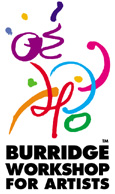

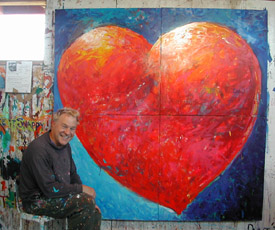

Copyright ©2007 Robert Burridge.
All rights reserved.
If you wish to copy this material to other publications or mail lists, please ask for permission by contacting:
Robert Burridge Studio
Arroyo Grande, California
805-459-1503
rburridge@robertburridge.com
www.robertburridge.com
|
|
|

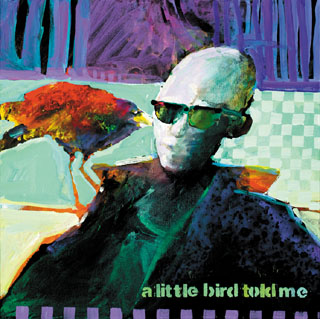
A Little Bird Told Me
Bob's Thoughts & Musings
I have been thinking about what makes some art more significant than others. Insignificant art, uninspiring paintings get unnoticed. Why? The artist had nothing to say. I look at their work and I feel nothing. The artist was either lazy or thought I'd be impressed with their slick presentation. It had no depth. So what makes art significant? The artist had specific intentions. The artist wrote down their goals for the painting. Their intentions became their focus, their theme, their big idea. These are the types of paintings that get my attention. The following is from my workshop handout.
How to Have More Meaningful
Intention in your Artwork
Creativity is being able to take facts, fiction and feelings, (your complete memory bank) and turn them into a metaphor. A metaphor is what is in all art.
The Goal. The Point. The Reason. Your Intentions. It is your initial impulse for the core of a meaningful painting. It is the essential preparatory step in the painting's creation. It's a starting point. Your first focus and the reason you are painting this in the first place. If it excites you, it's a good idea. Write it all down. Your intentions. Stick to your intentions and the piece will work. Out of integrity, the piece falls apart. The final result may not be so apparent to the art viewer, but you need it at the start.
Begin each day with a ritual of some sort. Rituals deal with overcoming fears. Rituals help clear the fog. Facing white canvas I am optimistic... with my ambition, passions, memories, goals. Optimism is productive (creative). Negativism is not (pessimism and fear).
The obstacle to good work is distraction. Doing good work takes a long time - uninterrupted. When I commit to a project I don't get involved in anything outside of the project. I'm fully invested in the task at hand. This is not the time for multitasking. I give the left side of my brain (logic) a rest and let the right side step forward (creative).
Be quiet and undistracted - Start goal setting. Pay attention to your thoughts and your goals will materialize. Your goal, your idea becomes your companion during your quiet time. Solitude is an unavoidable part of creativity. Don't be ambiguous - it has no focus or point. Get involved with your goal.
Avoid distractions: Clocks, newspapers, internet, television, mirrors.
Everyday you don't practice painting you're one day further from getting better at your work.
Artists we admire (and in ourselves as artists) take mundane materials and ideas, run it through their imaginations and surprise us.
Skill gets imprinted in your memory through repeated action. Think "concert pianist" (long repeated practice). Think Robert Motherwell's repeated warm-up exercises of making 100s of black lines and marks everyday. He coined it "automatism."

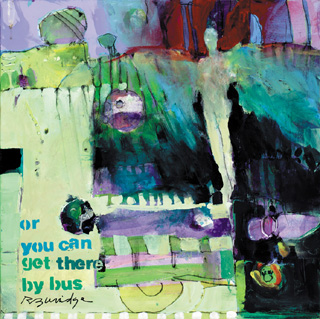
...or you can get there by bus
Some artists believe they must go way forward to be edgy and creative. However, progressive artists go back and pull ideas out from memory and reinterpret them in a new way.
Your sketchbook is an important tool. In fact, it IS your toolbox. When I was growing up, my dad always had a toolbox. He built his own. I would "inherit" his toolbox when he built a bigger one for himself. I've always had one. However, as an artist, I use my sketchbook as my toolbox. It has everything in it I need for pulling things out of for later. It's my physical memory bank.
Think of your sketchbook (writing, journaling, etc.) as your toolbox. It's easy to use. Inexpensive. Very functional, portable, disposable, eternal.
When your painting is completed, the sketchbook is a good history of your beginning idea, your words and drawings and is a good measuring stick to see if the painting is done. Does the painting "measure up" to your original idea (your goal) or did your painting idea take off and create a path of its own? Your sketchbook (toolbox) contains your history of ideas.
Start each studio day with Playtime first. Playtime is your wake-up time. Playtime is not about control. It's about unleashing mindless energy. You are all impulse and intention and you have to trust it. Trust the unconscious rush of pure play.
Keep the Oxford English Dictionary and a Thesaurus near you and look up words more often. Read it -- ideas will come to you.
Start by giving yourself a challenge. Such as, only using two colors in your warm-up painting exercises. Or not using a brush, but your fingers, or paint using only a paper towel.
The more I practice these warm-up exercises, the luckier I get.
Plan your day in the studio, but only up to a point. Overplanning is a false security blanket and leaves no room for chance, luck, surprises, etc. It's tempting to try and "get control" of the unruliness of the creative process. Getting everything in order before the wild process of making a creatively new painting can get out of hand and your planning goes too far. Plan only to a point. Leave room for play.
Too much perfection at the start of a painting (all the colors are out, the lighting is exact, the room temperature is perfect) is more about procrastination. Just get in there and start. All you really need to have for your next best work is a sense of urgency and your passion to create. I've seen too many artists working at setting up the "perfect" studio that they rarely painted in. Artists who had unlimited resources never really did significant work. (Except maybe John Singer Sargent who was enormously wealthy.)
Surround yourself with people who inspire you. Work with the best people you can find -- think Lennon/McCartney, Rogers/Hammerstein, Mozart/DaPonte, Stravinsky/Picasso (the ballet Pulcinella), Stravinsky/Balanchine (12 ballets), Twyla Tharp/David Byrne and Philip Glass, etc.


Vacation
How To Start An Idea
A good idea is one that turns you on, rather than shuts you off.
A better idea is two little good ideas together. If no idea, start painting a small idea. Start. More ideas will come along. Just start. To generate ideas, you have to start goofing around, doodling, scratching with paint. I call this "Play Time." Like a jazz musician, you need to improvise for awhile.
It's your rare opportunity in your life to be completely free. Not responsible to make something good. You are giving yourself permission to daydream while you work
Paint A Verb Warmup
Painting Exercise
Roget's Thesaurus is a good source for verbs. "Painting a verb" is about painting. It is about your creativity. If you tax yourself, you force yourself to stretch a little and you will astonish yourself... and others. The amazing thing is that everyone can do this.
By choosing to paint a Verb, it will generate ideas and one idea begets another to a point where you achieve a creative momentum that's hard to stop and takes you places you could never predict. Do this painting exercise daily.
Here are just a few ideas what I mean by painting verbs. Do a one minute paint sketch of your interpretation of the following list:
• to dance • to weep • to jump • to drink
• to travel • to smash • to wink • to soar
You get the idea. The list is endless and your creative juices will flow endlessly. You will paint nonstop. This is what we call "in the groove."
Painters get in their groove when the work just pours out of them. Unfortunately you don't recognize you are in a groove until you get out of it. When I'm in a paint-groove, at the end of the day in my studio I make certain I know what my next piece will be for tomorrow. I try not to stop when I'm out of ideas. I give myself a purpose for the next day in the studio. (This keeps me going.) Ernest Hemmingway always called it a day at a point when he knew what came next. He built himself a bridge for the next day.
My advice is when you go to your studio the next day, don't look back and analyze the previous day. Look forward. Start the day by looking at your original notes in your sketchbook and move forward from where you left off. You are fresher and a newer person.
When To Stop
Know that a painting is never finished. It just stops in interesting places. Some of us can kill a painting by tinkering, refining, redoing until we killed it. We all have some sort of stop signs. Writers have deadlines. Film makers have fixed premieres. Painters have gallery openings. I have a calendar.
For me, a painting is creatively finished when I feel everything is in its place and the painting gives me a thrill. There is order, harmony, a clear message and I'm happy. A good practice at this time is to name the piece. If I name it, it's done. I have to let it go and to go out into the world. I tell myself, it was the best of who I was then -- when I painted that painting. I am now a newer person, eager to start another one.
Creating a new body of work to be approved or validated by non-creative types is never advised. You will always look at them and wonder, "Who died and made you God?" Because you did. Surround yourself with critics who you admire and their talents and WITH others artists who don't feel they are competing with you.
It comes down to this. The validation you need that matters most is the kind that comes with no agenda, no personal baggage and is from the most talented people you know.
A painter is in it for the long haul. I am usually suspicious of those painters who are early bloomers (remember the 12 year old girl who painted like Chagall and Matisse? - ol' what's her name?) Or one-trick ponies or artists who keep repeating the same dogged theme? I believe these artists simply abandoned their artistic, creative gift.
A creative painter almost always has to eliminate every distraction that interrupts the creative process. Almost like placing yourself into an isolation chamber (your studio). It is not a particularly sociable way to live. It's actually antisocial. And it is actually procreative. Painters do better work when there are no distractions.
That is why some go off to secluded colonies; become artists-in-residence or take sabbaticals far away. But wherever you go, the bubble goes with you.
Being positive and knowing you have been preparing yourself your whole life for this next moment in front of your canvas is the best artist tool you can have. Optimism is the feeling all great masters have in preparation for their next creation.
How to Live Your Dream
Everyone should be so lucky to live their dream!
• Invest some time in yourself.
• Surround yourself with supportive people.
• Lean over the edge a little.
• Test out your dream.
• Talk to others.
• Be passionate about it.
• Take the high road - you'll look and feel better.
• Stick with it - even though you don't want to.
• Be out of touch so you can get away.
• Cut away all the extraneous stuff that does not serve you.
Do not allow others to influence you if they do not have your same dreams! No person has the right to instill or insert their "baggage" on your dreams. I continue to be aware of others who attempt to discourage me from doing things that they can't imagine doing themselves!
Keep your brushes wet!

|
|